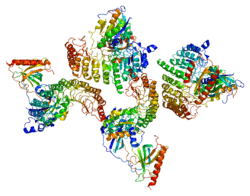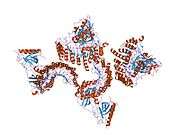RANBP1
Ran-specific binding protein 1 is an enzyme that in humans is encoded by the RANBP1 gene.[4][5][6]
Ran/TC4-binding protein, RanBP1, interacts specifically with GTP-charged RAN. RANBP1 encodes a 23-kD protein that binds to RAN complexed with GTP but not GDP. RANBP1 does not activate GTPase activity of RAN but does markedly increase GTP hydrolysis by the RanGTPase-activating protein (RanGAP1). The RANBP1 cDNA encodes a 201-amino acid protein that is 92% similar to its mouse homolog. In both mammalian cells and in yeast, RANBP1 acts as a negative regulator of RCC1 by inhibiting RCC1-stimulated guanine nucleotide release from RAN.[6]
Interactions
RANBP1 has been shown to interact with XPO1,[7][8] KPNB1[8][9] and Ran.[8][10][11]
References
- 1 2 3 GRCh38: Ensembl release 89: ENSG00000099901 - Ensembl, May 2017
- ↑ "Human PubMed Reference:".
- ↑ "Mouse PubMed Reference:".
- ↑ Hayashi N, Yokoyama N, Seki T, Azuma Y, Ohba T, Nishimoto T (August 1995). "RanBP1, a Ras-like nuclear G protein binding to Ran/TC4, inhibits RCC1 via Ran/TC4". Mol Gen Genet. 247 (6): 661–9. doi:10.1007/BF00290397. PMID 7616957.
- ↑ Kehlenbach RH, Dickmanns A, Kehlenbach A, Guan T, Gerace L (July 1999). "A Role for RanBP1 in the Release of CRM1 from the Nuclear Pore Complex in a Terminal Step of Nuclear Export". J Cell Biol. 145 (4): 645–57. doi:10.1083/jcb.145.4.645. PMC 2133185. PMID 10330396.
- 1 2 "Entrez Gene: RANBP1 RAN binding protein 1".
- ↑ Singh, B B; Patel H H; Roepman R; Schick D; Ferreira P A (December 1999). "The zinc finger cluster domain of RanBP2 is a specific docking site for the nuclear export factor, exportin-1". J. Biol. Chem. United States. 274 (52): 37370–8. doi:10.1074/jbc.274.52.37370. ISSN 0021-9258. PMID 10601307.
- 1 2 3 Plafker, K; Macara I G (May 2000). "Facilitated Nucleocytoplasmic Shuttling of the Ran Binding Protein RanBP1". Mol. Cell. Biol. United States. 20 (10): 3510–21. doi:10.1128/MCB.20.10.3510-3521.2000. ISSN 0270-7306. PMC 85643. PMID 10779340.
- ↑ Yaseen, N R; Blobel G (September 1999). "GTP hydrolysis links initiation and termination of nuclear import on the nucleoporin nup358". J. Biol. Chem. United States. 274 (37): 26493–502. doi:10.1074/jbc.274.37.26493. ISSN 0021-9258. PMID 10473610.
- ↑ Ren, M; Villamarin A; Shih A; Coutavas E; Moore M S; LoCurcio M; Clarke V; Oppenheim J D; D'Eustachio P; Rush M G (April 1995). "Separate domains of the Ran GTPase interact with different factors to regulate nuclear protein import and RNA processing". Mol. Cell. Biol. United States. 15 (4): 2117–24. ISSN 0270-7306. PMC 230439. PMID 7891706.
- ↑ Steggerda, S M; Paschal B M (July 2000). "The mammalian Mog1 protein is a guanine nucleotide release factor for Ran". J. Biol. Chem. United States. 275 (30): 23175–80. doi:10.1074/jbc.C000252200. ISSN 0021-9258. PMID 10811801.
Further reading
- Bischoff FR, Krebber H, Smirnova E, et al. (1995). "Co-activation of RanGTPase and inhibition of GTP dissociation by Ran-GTP binding protein RanBP1". EMBO J. 14 (4): 705–15. PMC 398135. PMID 7882974.
- Ren M, Villamarin A, Shih A, et al. (1995). "Separate domains of the Ran GTPase interact with different factors to regulate nuclear protein import and RNA processing". Mol. Cell. Biol. 15 (4): 2117–24. PMC 230439. PMID 7891706.
- Maruyama K, Sugano S (1994). "Oligo-capping: a simple method to replace the cap structure of eukaryotic mRNAs with oligoribonucleotides". Gene. 138 (1–2): 171–4. doi:10.1016/0378-1119(94)90802-8. PMID 8125298.
- Coutavas E, Ren M, Oppenheim JD, et al. (1994). "Characterization of proteins that interact with the cell-cycle regulatory protein Ran/TC4". Nature. 366 (6455): 585–7. Bibcode:1993Natur.366..585C. doi:10.1038/366585a0. PMID 8255297.
- Zolotukhin AS, Felber BK (1997). "Mutations in the nuclear export signal of human ran-binding protein RanBP1 block the Rev-mediated posttranscriptional regulation of human immunodeficiency virus type 1". J. Biol. Chem. 272 (17): 11356–60. doi:10.1074/jbc.272.17.11356. PMID 9111043.
- Suzuki Y, Yoshitomo-Nakagawa K, Maruyama K, et al. (1997). "Construction and characterization of a full length-enriched and a 5'-end-enriched cDNA library". Gene. 200 (1–2): 149–56. doi:10.1016/S0378-1119(97)00411-3. PMID 9373149.
- Plafker K, Macara IG (2000). "Facilitated Nucleocytoplasmic Shuttling of the Ran Binding Protein RanBP1". Mol. Cell. Biol. 20 (10): 3510–21. doi:10.1128/MCB.20.10.3510-3521.2000. PMC 85643. PMID 10779340.
- Steggerda SM, Paschal BM (2000). "The mammalian Mog1 protein is a guanine nucleotide release factor for Ran". J. Biol. Chem. 275 (30): 23175–80. doi:10.1074/jbc.C000252200. PMID 10811801.
- Maynard TM, Haskell GT, Bhasin N, et al. (2002). "RanBP1, a velocardiofacial/DiGeorge syndrome candidate gene, is expressed at sites of mesenchymal/epithelial induction". Mech. Dev. 111 (1–2): 177–80. doi:10.1016/S0925-4773(01)00616-5. PMID 11804793.
- Strausberg RL, Feingold EA, Grouse LH, et al. (2003). "Generation and initial analysis of more than 15,000 full-length human and mouse cDNA sequences". Proc. Natl. Acad. Sci. U.S.A. 99 (26): 16899–903. Bibcode:2002PNAS...9916899M. doi:10.1073/pnas.242603899. PMC 139241. PMID 12477932.
- Di Fiore B, Ciciarello M, Mangiacasale R, et al. (2004). "Mammalian RanBP1 regulates centrosome cohesion during mitosis". J. Cell Sci. 116 (Pt 16): 3399–411. doi:10.1242/jcs.00624. PMID 12840069.
- Seewald MJ, Kraemer A, Farkasovsky M, et al. (2003). "Biochemical Characterization of the Ran-RanBP1-RanGAP System: Are RanBP Proteins and the Acidic Tail of RanGAP Required for the Ran-RanGAP GTPase Reaction?". Mol. Cell. Biol. 23 (22): 8124–36. doi:10.1128/MCB.23.22.8124-8136.2003. PMC 262373. PMID 14585972.
- Ota T, Suzuki Y, Nishikawa T, et al. (2004). "Complete sequencing and characterization of 21,243 full-length human cDNAs". Nat. Genet. 36 (1): 40–5. doi:10.1038/ng1285. PMID 14702039.
- Bohlson SS, Zhang M, Ortiz CE, Tenner AJ (2005). "CD93 interacts with the PDZ domain-containing adaptor protein GIPC: implications in the modulation of phagocytosis". J. Leukoc. Biol. 77 (1): 80–9. doi:10.1189/jlb.0504305. PMID 15459234.
- Collins JE, Wright CL, Edwards CA, et al. (2005). "A genome annotation-driven approach to cloning the human ORFeome". Genome Biol. 5 (10): R84. doi:10.1186/gb-2004-5-10-r84. PMC 545604. PMID 15461802.
- Bruneel A, Labas V, Mailloux A, et al. (2006). "Proteomics of human umbilical vein endothelial cells applied to etoposide-induced apoptosis". Proteomics. 5 (15): 3876–84. doi:10.1002/pmic.200401239. PMID 16130169.
- Takeda E, Hieda M, Katahira J, Yoneda Y (2006). "Phosphorylation of RanGAP1 stabilizes its interaction with Ran and RanBP1". Cell Struct. Funct. 30 (2): 69–80. doi:10.1247/csf.30.69. PMID 16428860.
- Ewing RM, Chu P, Elisma F, et al. (2007). "Large-scale mapping of human protein–protein interactions by mass spectrometry". Mol. Syst. Biol. 3 (1): 89. doi:10.1038/msb4100134. PMC 1847948. PMID 17353931.
This article is issued from
Wikipedia.
The text is licensed under Creative Commons - Attribution - Sharealike.
Additional terms may apply for the media files.




